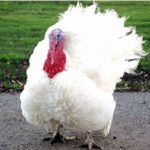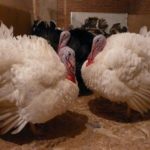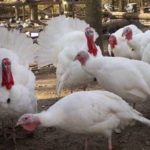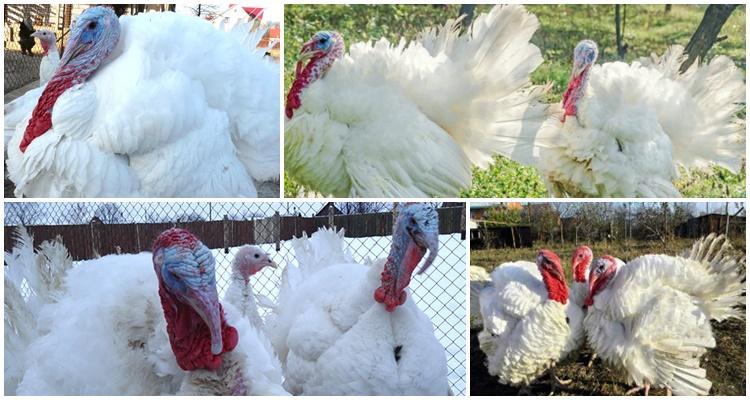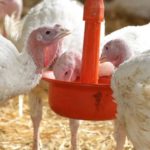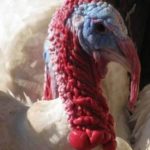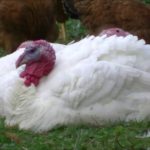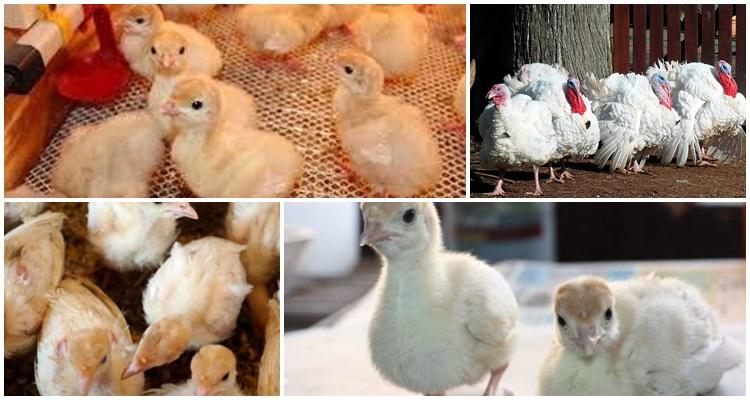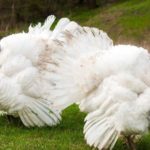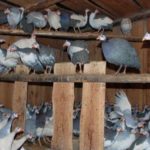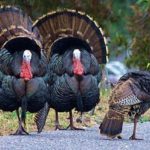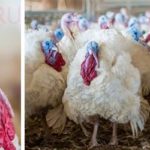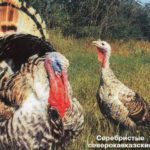Turkeys of the heavy-weight line Big-6 weigh more than 25 kg at six months. The birds have a calm character; they do not require special conditions or specific feed. This cross is recommended for home and industrial cultivation. The main feature of the Big-6 breed is its early maturity. Turkeys on regular feed recover quickly and can be sent to slaughter at the end of the warm season.
Description and characteristics of the cross
Turkeys of the Big-6 breed (B.U.T.6) bred by the English company British United Turkeys LTD. The cross is distinguished by its rapid weight gain and high taste characteristics of the meat. Big 6 is the most popular breed among poultry farmers from different countries.
Appearance
Big 6 turkeys have white plumage. The light and soft down of these birds is of considerable value. Turkeys have a large body, large wings, a fan-shaped tail, a long neck, a convex and wide chest, and straight light yellow legs. The head is small, unfeathered, males have scarlet earrings and a hanging beard. Externally, the birds look like large white balls. Males are larger than females.
Meat yield
Males of the Big-6 cross at 6 months of age weigh more than 25 kg, females - about 15 kg. At six months, turkeys are usually sent to slaughter. The slaughter yield of meat is almost 80 percent. Moreover, the breast accounts for 30%, and the thighs - 14%. The Big-6 breed is characterized by intensive growth rates.
Weight table by week and day for Big-6:
| Months | weeks | Days | Weight |
| 1 | 4 | 28 | 1,27 |
| 2 | 8 | 56 | 4,81 |
| 3 | 12 | 84 | 9,88 |
| 4 | 16 | 112 | 15,30 |
| 5 | 20 | 140 | 20,39 |
| 6 | 24 | 168 | 25,15 |
Egg production
Females of the Big-6 broiler breed lay eggs starting at 8 months of age. One bird produces about 100 eggs per year. Young turkeys have the highest egg production. The weight of one egg is 85 grams. They can be eaten. Only fertilized eggs should be used for laying.
Maternal instinct
The Big-6 turkey usually lays eggs in the spring. The breed has a well-developed maternal instinct. The bird does not leave the clutch throughout the entire incubation period (28 days) and takes care of the offspring until the chicks reach 2 months of age. Almost 95 percent of the young survive.
Positive and negative sides
Requirements for maintenance and care
Poultry farmers who want to raise birds from scratch should remember that to keep Big 6 turkeys you need a large poultry house and a walking yard. During the warm season, birds can be outside all day. When turkeys are kept in a cramped and dark room, there is a decrease in the rate of weight gain and egg production. For 1 sq. two adult birds can fit in a meter of space.
Perches and nests are installed in the poultry house (with a hood and windows near the ceiling). Big-6 turkeys do not like to sleep on the floor. These birds are sensitive to dampness and dirt. The litter (straw) needs to be changed as it gets dirty. The poultry house should be dry and warm (not higher than +22 and not lower than +10 degrees Celsius).
Perches are made from wooden beams and are placed at a height of 80 cm from the floor at the same level. There should be 40 centimeters per bird. The distance between the beams should be at least 60 cm. Wooden boxes or wicker baskets can be used as nests. Place them in a secluded corner on the floor or at a height (on a shelf).
It is recommended to place feeders and drinking bowls on the walking area. There should be a sand-ash bath, a shell shell, and crushed chalk outside. It is advisable to fence the walking area with a net 2 meters high. Turkeys fly well. In winter, it is better not to let birds go outside when it is cold. During the cold season, the air temperature in the poultry house should not fall below 10 degrees Celsius.
Feeding
Newly hatched Big-6 chicks are fed 5-7 times a day with chopped eggs, cottage cheese, millet and yogurt. The turkey poults are gradually transferred to starter feed and crushed grain mixtures. The birds recover quickly and gain good weight on boiled potatoes, chopped corn and wet mash. The diet of broilers should include finely chopped vegetables (carrots, fodder beets, pumpkin) and greens. Do not give red beets to birds (pecking may occur).
Adult Big-6 turkeys are fed three times a day. Grains should make up 65 percent of a bird's total diet. Turkeys are additionally given ground herbs, feed yeast, limestone, fish and bone meal, chalk, sunflower cake, premixes, and salt. Adult birds can be fed whole grains. Wet mash (compound feed and chopped vegetables) is usually placed in feeders at lunchtime. It is recommended to remove the remaining feed. Sour mash can cause intestinal diseases in turkeys.
In order to raise healthy Big-6 turkeys, you need to provide them with high-quality grain feed, vegetables (greens), and compound feed. In winter, it is recommended to add pharmaceutical vitamins and minerals to your drink. As a preventive measure against diseases, birds are given crushed pine needles and green onions (feathers). Turkeys must be provided with clean water. It is changed daily.
Breeding at home
Representatives of the Big 6 cross are recommended to be mated with lighter breeds of turkeys. Hybrid turkey poults gain weight faster and have a more disease-resistant immune system. Those who want purebred turkeys can buy fertilized eggs for the incubator or unfledged chicks. It is better to buy young animals from breeding farms that breed and raise Big-6 crosses.
The birds' eggs hatch after 28 days. If there was a hen sitting on the clutch, the turkey chicks can be left with the female. Big-6 chicks hatched in the incubator should be placed in a cardboard box and kept under heating lamps for the first week of life at a temperature of +27...+30 degrees Celsius.
Big-6 chicks typically hatch in the spring. When the temperature outside is above +20 degrees Celsius, the young animals can be released for a walk. The chicks are fed 5-7 times a day with millet, crushed corn grits, cottage cheese, crushed eggs, and yogurt. You can give your turkeys sweetened water. The birds are gradually transferred to adult food. To improve the health of chicks, on the 3rd day of life, Levomycetin is added once to their food in minimal doses.
Diseases and treatment
Big 6 cross turkeys have good immunity. With proper care and feeding with high-quality feed, birds almost never get sick. As a preventive measure against intestinal infections, turkey poults can be given a broad-spectrum antibiotic (Levomycetin) in their food or drink in minimal doses on the 3rd day of life.
Big 6 turkeys are susceptible to the following diseases:
- coccidiosis (loss of appetite, decreased activity, diarrhea with foam and blood) - treated with antibiotics (Baycox, Coccidin);
- pullorosis (heavy breathing, white diarrhea, poor coordination of movements) - treated with antibiotics (Levomycetin, Furazolidone);
- invasive diseases, that is, giardiasis, histomoniasis (greenish-brown diarrhea) - give antiparasitic drugs;
- trichomoniasis (lack of appetite, foamy diarrhea) - use Brometronide, Brovaseptol, antibiotic Baytril;
- syngamosis (parasites accumulate in the bronchi, birds breathe heavily, mucus accumulates in the beak) - give anthelmintic drugs (Fenbendazole, Levamisole);
- colibacillosis (refusal to eat, diarrhea) - treated with Enronit, Lexoflon;
- salmonellosis (nasal discharge, white-yellow diarrhea, lethargy) - vaccination is possible, treated with Baytril, Enromag, Enrofloxacin;
- cannibalism (pecking) - occurs when there is a deficiency of nutrients; it is recommended to give vitamin and mineral preparations as a preventive measure.
The course of antibiotic treatment is 5-7 days. As a preventative measure, Big-6 birds are fed antibacterial agents for no longer than 3 days (sometimes 1 day). After treatment with antibiotics, it is recommended to give turkeys probiotics (Colibacterin, Bifitrilak) or regular kefir, yogurt.


